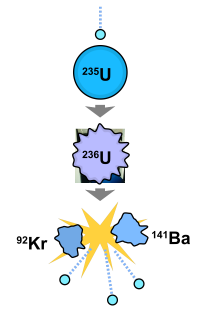Kernspaltung
Bildinfo und Lizenz
Bildinfo
- Eine typische Kernspaltung: ein Urankern wird von einem U235 Atomkern eingefangen. Der Kern besteht kurzzeitig als angeregter U236 Kern. In einem dritten Schritt zerfällt der Kern in zwei ähnlich große Tochterkerne: Barium und Krypton. Außerdem werden weitere kleinere Spaltprodukte sowie Energie freigesetzt.
- Simple diagram of nuclear fission. In the first frame, a neutron is about to be captured by the nucleus of a U-235 atom. In the second frame, the neutron has been absorbed and briefly turned the nucleus into a highly excited U-236 atom. In the third frame, the U-236 atom has fissioned, resulting in two fission fragments (Ba-141 and Kr-92) and three neutrons, all with very large amounts of kinetic energy.
Source
- Created: December 30th, 2005
- Author: Fastfission (Wikimedia)
License
Wikimedia: This work has been released into the public domain by its author, Fastfission. This applies worldwide. In some countries this may not be legally possible; if so: Fastfission grants anyone the right to use this work for any purpose, without any conditions, unless such conditions are required by law.
Warranty
- No guarantee can be given as to the correctness of facts implied or explicitly stated.
- Usage is completey at your own risk. 💣
Originalseite
- Das Bild ist Teil eines online-Lexikons.
- Rhetos Lernlexikon Mathematik, Aachen:
- Siehe unter => Kernspaltung
 Eine typische Kernspaltung: ein Urankern wird von einem U235 Atomkern eingefangen. Der Kern besteht kurzzeitig als angeregter U236 Kern. In einem dritten Schritt zerfällt der Kern in zwei ähnlich große Tochterkerne: Barium und Krypton. Außerdem werden weitere kleinere Spaltprodukte sowie Energie freigesetzt.
© Fastfission (Wikimedia) => Zurück zum Artikel
Eine typische Kernspaltung: ein Urankern wird von einem U235 Atomkern eingefangen. Der Kern besteht kurzzeitig als angeregter U236 Kern. In einem dritten Schritt zerfällt der Kern in zwei ähnlich große Tochterkerne: Barium und Krypton. Außerdem werden weitere kleinere Spaltprodukte sowie Energie freigesetzt.
© Fastfission (Wikimedia) => Zurück zum Artikel